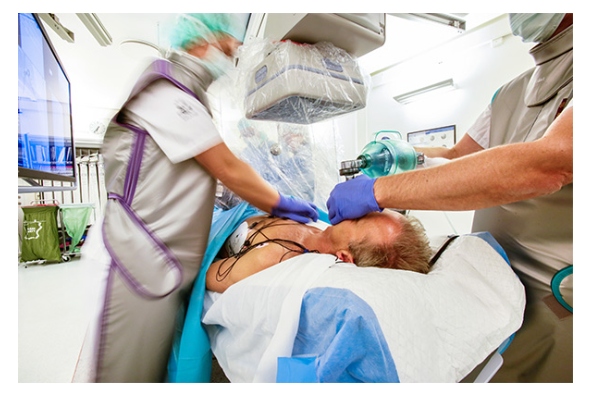A chest compression feedback device is a piece of medical equipment designed to provide real-time feedback and guidance to healthcare professionals or bystanders performing chest compressions during cardiopulmonary resuscitation (CPR). These devices are used to ensure that chest compressions are administered with the appropriate depth, rate, and technique, which is crucial for effectively circulating blood and oxygen to the brain and vital organs in a person experiencing cardiac arrest.
What are the key features and functions of chest compression feedback devices?
Depth Monitoring: They measure and provide feedback on the depth of each chest compression to ensure it reaches the recommended depth (typically around 2 inches or 5 centimeters for adults).
Rate Monitoring: These devices monitor the rate at which chest compressions are delivered, ensuring that it falls within the recommended range (typically between 100 and 120 compressions per minute for adults).
Recoil Detection: Proper chest recoil between compressions is essential to allow for adequate blood flow during CPR. Feedback devices can alert the user if they are not allowing for full chest recoil.
Hand Positioning Guidance: Some devices offer guidance on proper hand placement to ensure that chest compressions are administered in the correct location on the chest.
Audible and Visual Feedback: Many chest compression feedback devices provide real-time feedback through audible tones or visual displays, indicating whether compressions are being performed correctly or if adjustments are needed.
Compression Fraction: They calculate and display the percentage of time during CPR that chest compressions are being administered, helping users maintain a high compression fraction for optimal CPR quality.
Data Recording: Some devices record CPR data for later review and debriefing, allowing healthcare providers to assess the quality of CPR performed during a resuscitation event.
Integration with Automated External Defibrillators (AEDs): In some cases, these devices are integrated with AEDs to provide comprehensive guidance during sudden cardiac arrest emergencies.
Uses
A chest compression feedback device, commonly used in cardiopulmonary resuscitation (CPR), is designed to monitor and provide feedback on the quality of chest compressions during the resuscitation of a person in cardiac arrest. These devices are often used in conjunction with automated external defibrillators (AEDs) or as standalone tools to improve the effectiveness of CPR.
What does a chest compression feedback device monitor?
Here are the main parameters and aspects that a chest compression feedback device typically monitors:
Compression Depth: It measures the depth of each chest compression. The American Heart Association (AHA) and other guidelines recommend compressions of at least 2 inches (5 centimeters) deep for adults.
Compression Rate: It monitors the rate at which chest compressions are being performed. The recommended compression rate for adults is typically between 100 and 120 compressions per minute.
Recoil: A critical aspect of CPR is allowing the chest to fully recoil between compressions. The device can detect if the chest is not fully recoiling after each compression.
Hand Position: Proper hand placement on the chest is crucial to ensure that compressions are effective. The device can provide feedback on hand placement.
Compression Fraction: This metric represents the percentage of time during CPR that chest compressions are being performed. A higher compression fraction indicates more effective CPR.
Rate and Depth Consistency: The device can provide feedback on the consistency of compression rate and depth to help maintain the quality of CPR over time.
Visual and Audible Feedback: Many chest compression feedback devices have visual displays or audible cues to guide the rescuer in real-time, indicating whether they should push harder, push softer, push faster, or slow down.
Real-time Data Recording: Some devices record data over the course of CPR, which can be useful for debriefing and reviewing the quality of CPR after the event.
These devices are valuable tools for healthcare providers and laypersons alike, as they help ensure that CPR is administered correctly and with the necessary quality to maximize the chances of survival for a person in cardiac arrest. They provide immediate feedback and guidance to rescuers, helping them maintain effective chest compressions until professional medical help arrives.
How does Chest Compression Devices Help?
- Provide consistent quality of chest compressions during resuscitation attempts
- Create life-sustaining perfusion of the brain and heart of the patient
- Create good neurological outcomes
- The device helps by Freeing up hands and reducing chaos around the patient
- Devices also allows us to Calms down the scene and buying time to make decisions
- They Provide CPR guidance and data for feedback
Where do we require these devices?
The use of mechanical CPR devices may be considered in specific settings where the delivery of high-quality manual compressions may be challenging or dangerous for the provider, as long as rescuers strictly limit interruptions in CPR during deployment and removal of the device.”
Reference: AHA 2020 Guidelines. Circulation. 2020;142(suppl 2):S366–S468
Cons
The optimal timing for deploying a mechanical device during a cardiac arrest is uncertain, especially in patients who present with a shockable rhythm. The deployment process involves interrupting chest compressions, which can be detrimental if the pause is prolonged. It is recommended that the use of mechanical devices should only occur in systems that have quality assurance mechanisms in place to monitor and handle pauses associated with deployment.
Mechanical CPR devices may be helpful in certain circumstances as an additional treatment option, but there is not enough evidence to support their regular use.
Reference:
Mechanical CPR: Who? When? How?
https://www.ncbi.nlm.nih.gov/pmc/articles/PMC597540
Summary
Chest compression feedback devices are used to improve the quality of CPR and increase the chances of survival for individuals in cardiac arrest. They are particularly valuable for ensuring that even untrained or less experienced individuals can deliver effective chest compressions when needed. These devices play a crucial role in promoting high-quality CPR and ultimately saving lives during cardiac emergencies.
Real-time Guidance in CPR Chest Compression Feedback Devices pdf

